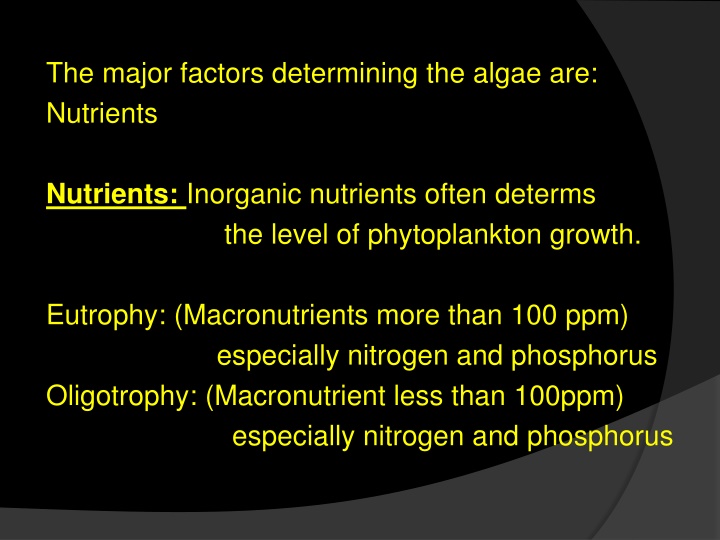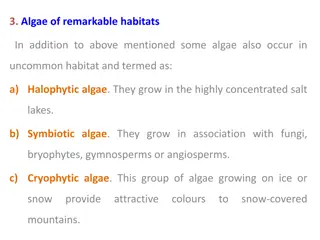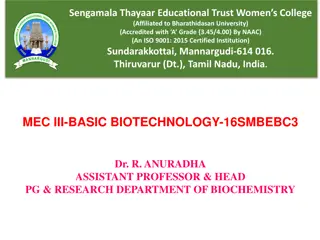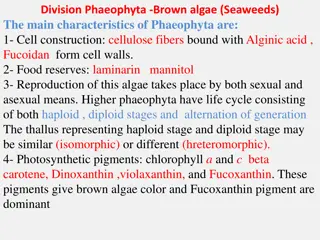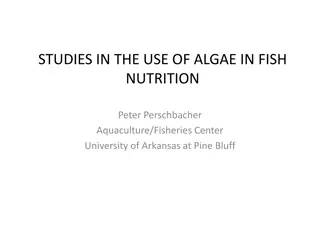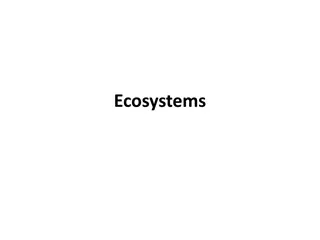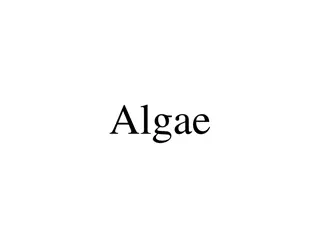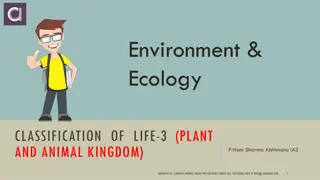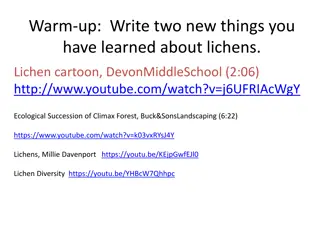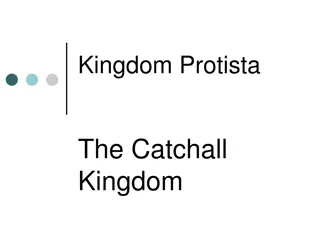Factors Influencing Algae Growth in Water Ecosystems
Nutrients play a crucial role in algae growth, with inorganic nutrients like nitrogen and phosphorus being key factors. Algae require macroelements such as carbon, hydrogen, oxygen, sulfur, potassium, calcium, phosphorus, and nitrogen in large quantities, as well as microelements like iron, manganese, copper, zinc, and molybdenum in smaller quantities. Nitrogen exists in various forms in water, and algae primarily use nitrate and ammonium. Phosphorus uptake is mainly as phosphate. The pH of the water is also important, with different algae species requiring specific pH ranges for optimal growth.
Download Presentation

Please find below an Image/Link to download the presentation.
The content on the website is provided AS IS for your information and personal use only. It may not be sold, licensed, or shared on other websites without obtaining consent from the author.If you encounter any issues during the download, it is possible that the publisher has removed the file from their server.
You are allowed to download the files provided on this website for personal or commercial use, subject to the condition that they are used lawfully. All files are the property of their respective owners.
The content on the website is provided AS IS for your information and personal use only. It may not be sold, licensed, or shared on other websites without obtaining consent from the author.
E N D
Presentation Transcript
The major factors determining the algae are: Nutrients Nutrients: Inorganic nutrients often determs the level of phytoplankton growth. Eutrophy: (Macronutrients more than 100 ppm) especially nitrogen and phosphorus Oligotrophy: (Macronutrient less than 100ppm) especially nitrogen and phosphorus
Macroelements: (Carbon, Hydrogen, oxygen, Sulfur,Potassium,Calcium, Phosphorus and Nitrogen)Algae require in mach large Quantities. Microelements:(Iron,Manganise,Cooper,Zinc, And Molybidium)Algae require much lower Quantities often as cofactors in enzyme systems
Nitrogen: nitrogen occurens in adifferent forms in water(atomic nitrogen N2, ammonium NH4, nitrate NO3, nitrite NO2, other nitrogen oxides, And organic compounds. Nitrate and ammonium are the primary forms that algae use, but most algae can also nitrite, urea and other form of organic compounds. Nitrogen gas N2 is available only to Cyanobacteria capaple of nitrogen fixation.
NO3- NO2- NH4+ Urea urea N2 NO3- NO2- NH4+ glutamine N2 NH4+ Other amino
Phosphorus: The total phosphorus of water consist(dissolved inorganic phosphorus,dissolve organic compounds with phosphorus and Organic phosphorus in suspended particles. While algae may utilize several different forms of nitrogen,phosphorus uptake is almost exclusively as phosphote(Po4).
phosphorus is low but organic forms are available .Algae may excrete phosphatase to break down phosphate compounds. Natural phosphorus is derived from rock weathering, biological sources and also present in many pollutants. Silicon: silicon is derived from rock weathering and dissolves in water as orthosilicic acid [Si(oH)4] from natural process and human discharges.
pH - Fresh water systems normally have a pH between (6-9) while sea water between (7.8-8.2) - Alkophilic: Algae require high value of PH between(8-10) such as spirulina - Acidophilic: Algae require low value of PH between (4.0-6.5) such as calothrix
Temperature: Thermophilic algae: (35-85) c Aphanocapsa thermails Mesophilic algae: (15-35) c Karyophilic algae: (15- less than zero) Chlamydomonas nivalis
Salinity: - Fresh water algae: (0.5-5) ppt. - Brkish water algae: (5-18) ppt. - Marin water algae (18-35) ppt. Halotolerant algae adapted to the high salinity in three ways - : - 1- Active export of inorganic ions in the protoplasm leading to relatively unchanged internal salt concentration 2- Accumulation of organic osmoprotective compounds, such as glucosylglycerol, glycine, and betain (traimethylglycine), to maintain the osmotic equilibrium
Phytoplanktaaon Fresh water and Marine water Phytoplankton: Algae live free-floating in the Water without association with submerged substrates - According to size the phytoplankton dividing into three Categories; A-Microplankton: (20-200) m B-Nanoplankton: (2-20) m C-Picoplankton: (less than 20) m
Benthic and Terrestrial Algae Benthic algae (Phytobenthos): Are growing submerged surfaces in fresh water ,marin environment and terrestrial algae growing on moist surfaces exposed to the air, including symbiotic algae in these habitats. -Freshwater benthic algae include: A- Flowing water in rivers and streams B- Standing water in lakes, pond sand bogs. - Each of these habitats can contain a variety of substrates for algal growth including rock, sand, mud and the surfaces of other organism. 9
There are different terms that describe benthic algae according to substrates: 1-Epilithic:growing on rocks. 2-Endolithic: growing within rocks. 3-Epipsamic: growing on sand. 4-Endopsamic: growing among sand grains. 5-Epipelic: growing on mud. 6-Endopelic: growing within mud. 7-Epiphytic: growing on other algae or plants. 8-Endophytic: growing within other algae or plants. 9-Epilignic: growing on wood of trees. 10-Epizoic: growing on animals.
Terrestrial algae: Algae grow exposed to the air on the surfaces of soil rocks, sands, trees and snow - There are different terms that describe terrestrial algae according to substrates 1- lithophytes: grow on the moist earth and rocks. 2- Chasmolithics: grow within earth and rocks 3- Epidaphics: grow on the sand 4- Endodaphics: grow within sand 5- Epiphyllophytes: grow on the trees 6- Epiphloephytes: grow within trees
Terrestrial algae play a major role in the establishment of a soil flora and in the accumulation of hums. They do this in far main ways. 1- They bind sand and soil particles and prevent erosion. They do this with their gelatinous sheaths and by their growth pattern which produced closely intertwined rope-like bundles in and among soil particles
2- They help to maintain moisture in the soil. 3- They are important as contributors of combined nitrogen through nitrogen fixation. 4- If has been suggested that algae especially Cyanobacteria assist higher plant growth by supplying growth substrates
Symbiotic algae: In freshwater environments unicellular green algaeChlorella occure as endosymbionts (Zoochlorella) in cells of . Lichens: Azolla(mycobiont)+Anabaena(phycobionts)
